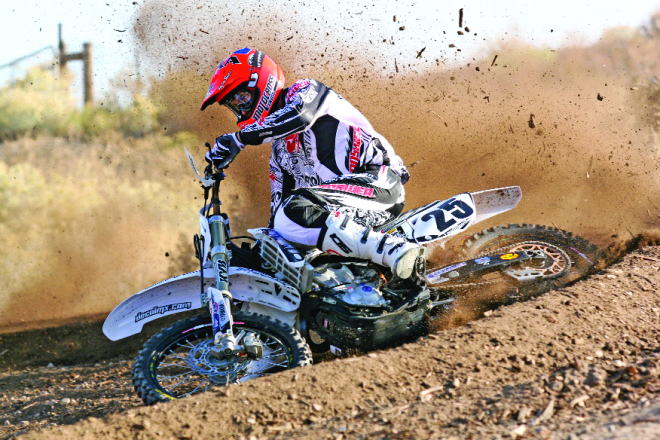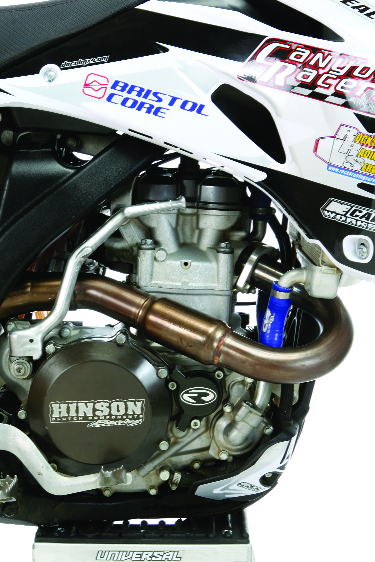WE RIDE THE ROCK’S RACING STEALTH YAMAHA YZ450F:

The funny thing about slow bikes is that everyone who races them goes just as fast as on their fast bikes, save for the pros.
Some race bikes are easy to test. Everything goes perfectly and all the MXA wrecking crew has to do is show up, throw a leg over the bike and go to the starting line. If the bike is James Stewart’s, Chad Reed’s, Ryan Villopoto’s or Travis Pastrana’s, we don’t even have to bring gas, lunch or tools. Such was not the case with Rock’s Racing’s Project Stealth YZ450F.
Michael “The Rock” Rigdon, for those of you who don’t follow the politics of motorcycle noise, is a self-proclaimed sound advocate. He has dedicated a large portion of his daily life to trying to get the AMA, motorcycle manufacturers, exhaust pipe companies and local racers to accept that quieter motocross bikes are not only good for the environment, but good enough to race.
The problem for most activists is that they can only scream from the hill tops so many times before people stop listening to their rants. It should be noted that “The Rock” is by no means the first person to try to bring about a watermark change in the exhaust note of American motorcycling. Over 40 years ago, the motorcycle industry gave lip service and financial backing to a movement known as “Less Sound=More Ground.” And perhaps it worked, since motocross went from straight pipes (with no silencers) to muffled expansion chambers. But, over the ensuing 40 years very little progress was made…until the four-stroke movement caused a tectonic shift in the sound levels. Although the two-strokes were loud, it doesn’t take a rocket scientist to realize that four-stroke noise carries farther and is more obnoxious. Bikes with different engine designs (two or four-stroke) could have identical decibels at 20 inches, but at 50 feet the four-stroke would be more intense to the ear.

<—-With the 94dB insert installed in the Factory 4.1 exhaust, the Stealth YZ450F was remarkably quiet. By pulling the insert out we could have perked up low-end throttle response at the cost of some volume.
And that is where Rock’s Racing came into play. Rigdon decided that haranguing other people to build a competitive, but quiet, motocross bike without a full understanding of the problems they faced wasn’t hands-on enough. Rigdon owns a motocross accessory company, Rock’s Racing, through which he reps for a cadre of aftermarket companies. His original thought was to build a full-race motocross bike that produced competitive horsepower and produced less than 94dB.
IT WAS A WORTHY GOAL WHEN HE STARTED THE PROJECT, BECAUSE AT THE TIME THE AMA HADN’T PASSED ITS 94dB RULE, BUT THE TIME IT TOOK FROM CONCEPT TO ACTUAL BIKE DROVE THE MXA GANG CRAZY.
SHOP TALK: WHAT PARTS WERE USED? It was a worthy goal when he started the project, because at the time the AMA hadn’t passed its 94dB rule, but the time it took from concept to actual bike drove the MXA gang crazy. Several times we wanted to tell the Rock to leave us alone, because he had more false starts than a blind man crossing Fifth Avenue.
According to the Rock, “I came up with the idea to build a quiet bike but with good power. The universally accepted opinion was that if you made them quiet, then they wouldn’t run very well. My only experience at that time was with the DB Dawg, so in November of 2007 I started working on the Stealth project.”
Had the Rock’s Racing Stealth bike been finished in 2007, it would have been a groundbreaking enterprise. Unfortunately, when Rigdon finished the bike and presented it to the MXA wrecking crew to test, we took one look at the YZ450F frame and discovered a huge crack running down the head tube gusseting. We refused to ride the bike.
Back in 2007, Rock’s Racing was working with Tru-Tech and Jardine. About six months later, Rock had a new frame installed and had switched some of the suppliers. Again the bike arrived for a test, but instead of accepting it, we told the Rock that perhaps he should get a qualified test rider to try it first. That way we wouldn’t be wasting our time (for a second time). Rigdon chose former AMA National rider and Honda of Troy maven Phil Alderton to do the freelance testing. After Alderton rode the bike, he told the Rock that whatever had been done to the engine was all wrong. The bike was quiet, but it was slow. “Very slow,” according to Alderton. Again, the bike was sent home for more retooling.

Taste is acquired and the stark black and white look of the Stealth YZ450F wasn’t a hit with every MXA test rider, but it did stand out.
“I had come too far to turn back, though,” said the Rock. “I did additional research, made phone calls and got WebCam, FMF, Canyon Racers, ARC levers, Loudmouth, DeCal Works, Ride Engineering, Nuetech, Cycra, Enzo, Ready Racing, Hinson, Merge, Moto Master, Bristol Core, Hot Rods and MaxPower on board. In all honesty, if I had any inkling of what a major deal this project was going to be, I would never have embarked on it.”
“WHEN HE FIRST APPROACHED US ABOUT HIS STEALTH PROJECT BIKE BACK IN 2007, HE WAS LIKE A CRUSADER OUT TO PROVE THAT QUIET BIKES COULD BE MADE THAT PRODUCED COMPETITIVE HORSEPOWER. BUT THE LONGER HE WORKED ON THE PROJECT…”
WHAT WAS UNIQUE ABOUT ROCK’S RACING STEALTH YZ450F? It was obvious from the beginning that Rigdon’s interest in sound levels was his primary focus (starting with his initial interest in the stuffer-like DB Dawg to his association with packing manufacturer Bristol Core). Conversely, the MXA wrecking crew saw a noticeable change in his attitude about the hop-up companies and pipe manufacturers as the project dragged on. When he first approached us about his Stealth project bike back in 2007, he was like a crusader out to prove that quiet bikes could be made that produced competitive horsepower. But the longer he worked on the project and the more setbacks he had, the more grudging respect he gave to the race teams and their desire for horsepower. Over a year later, when he finally handed the bike over to the MXA wrecking crew (and we were willing to take it), his tune had changed from “building a fast bike that was quiet” to “building a quiet bike that was easy to ride.”
HOW FAST WAS IT? It wasn’t fast. In an effort to make the bike quiet, the compression had been lowered. The FMF Factory 4.1 exhaust had been fitted with a small diameter 94dB end cap. A Bristol 4.1 perforated core was used, along with Bristol Core’s chain mail-like core sleeve (which is a 430 stainless steel and wool wrap that protects the muffler packing from the heat of the exhaust). As a result, the power was mellow. It didn’t have any significant hit, and it often took a couple city blocks (assuming we were racing down your street instead of at Glen Helen) to get from the bottom end to the top end. By no means did this bike belch fire and spit flames.
Every test rider thought the bike was slow?some thought it was too slow. Yet, when we raced the bike it was, as Rock’s ever-changing mission statement implied, “easy to ride.” The smoothness of the powerband made for effortless racing. There was none of that normal rushing around; you just pegged the throttle and didn’t have to worry about wheelying over backwards. Every test rider said that they didn’t get as tired and that the reduction in obnoxious noise was soothing at speed. It turned out that the test riders’ race results did not change much between racing the slower Stealth bike and their faster full-race bikes. The exception to this rule was the faster test riders. Pro test riders wanted nothing to do with the bike and were much faster on faster motorcycles.
“DYNOING THIS BIKE WAS MORE OF A SELF-FULFILLING PROPHECY THAN RIGOROUS SCIENTIFIC EXAMINATION.”

Rock’s Racing’s engine package combined the efforts of virtually every major player in the hop-up business. Their workmanship was first rate. ———>
The strange thing was that while the Stealth bike made competitive low-to-mid horsepower (especially compared to a stock 2009 YZ450F), its overall powerband negated this by being slow revving and lazy.
It should be noted that although the Stealth YZ450F was a 2007 model that had been on the hop-up merry go-round for well over a year, it was equipped with topnotch equipment (not the least of which was Enzo suspension, a Hinson clutch, FMF exhaust, WebCam cam and Ride Engineering components).
HOW QUIET WAS IT? As silly as it may sound, there are two kinds of quiet in the motocross world.
(1) The first is AMA bureaucratic quiet. This is a bike that is 94dB (plus about two decibels of fudge factor) at the mandated 4500 rpm. After 4500 rpm, it might be as loud as 112 decibels.
(2) The second kind is real world quiet. The Stealth bike passed the AMA sound test with ease at 94dB, but as the rpm rose it didn’t make a quantum leap up on the decibel scale. It was noticeably quieter throughout the rpm range than your typical AMA-legal bike.
VERDICT: WHAT DO WE THINK? Starting in 2011, the AMA will require all bikes to meet the 94dB standard for amateur motocross and offroad competition. That is when the technology that went into Rock’s Racing’s Stealth bike will undergo its true test. As for the MXA test riders, we’re not exactly sure that “The Rock” succeeded. When he started on the project, his 94dB bike would have been a newsmaker?but by the time he finished it, we felt that a very vocal sound advocate should have been trying to make a 90dB bike.
For more info, go to www.rocksracingservices.com





Comments are closed.